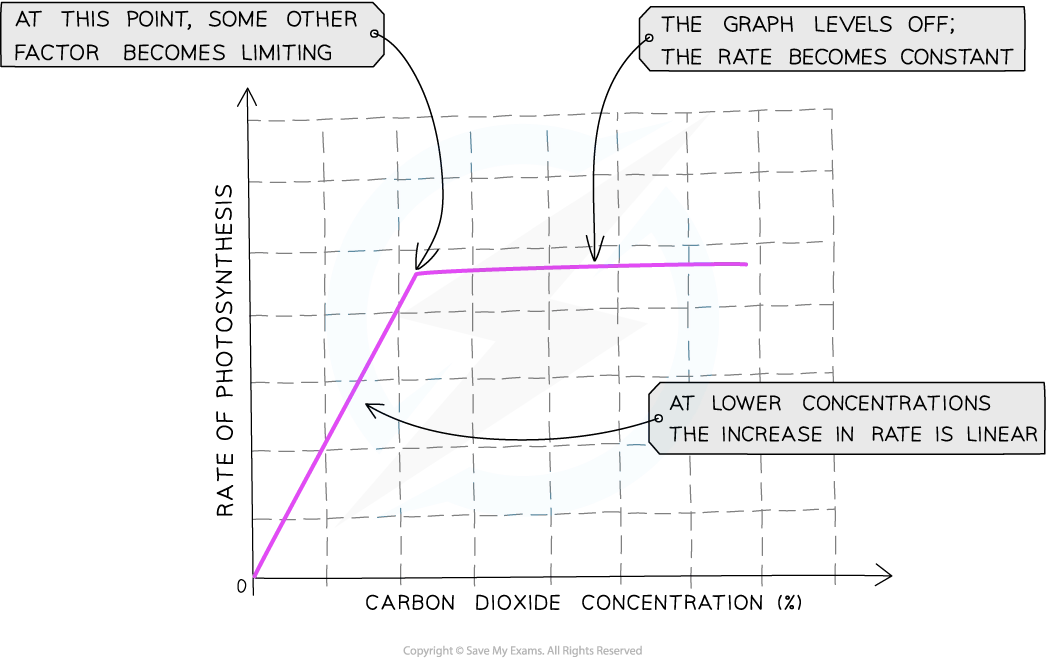Limiting Factors of Photosynthesis (Cambridge (CIE) A Level Biology): Revision Note
Exam code: 9700
Limiting factors of photosynthesis
Plants need several factors for photosynthesis to occur:
The presence of photosynthetic pigments
A supply of carbon dioxide
A supply of water
Light energy
A suitable temperature
If there is a shortage of any of these factors, photosynthesis cannot occur at its maximum possible rate
The main external factors that affect the rate of photosynthesis are:
light intensity
carbon dioxide concentration
temperature
These are known as the limiting factors of photosynthesis
If any one of these factors is below the optimum level for the plant, its rate of photosynthesis will be reduced, even if the other two factors are at the optimum level
Examiner Tips and Tricks
Light intensity, CO2 concentration and temperature are the three limiting factors of photosynthesis that you need to learn.
Although a lack of water can reduce the rate of photosynthesis, water shortages usually affect other processes in the plant before affecting photosynthesis.
Limiting factors of photosynthesis: effects
Light intensity
When temperature and carbon dioxide concentration remain constant, changes in light intensity affect the rate of photosynthesis
The rate of photosynthesis increases as light intensity increases:
The greater the light intensity, the more energy is supplied to the plant and therefore the faster the light-dependent stage of photosynthesis can occur
This produces more ATP and reduced NADP for the Calvin cycle (light-independent stage), which can then also occur at a greater rate
During this stage of the graph below, light intensity is said to be a limiting factor of photosynthesis
At some point, if light intensity continues to increase, the relationship above will no longer apply and the rate of photosynthesis will reach a plateau
At this point, light intensity is no longer a limiting factor of photosynthesis – another factor is limiting the rate of photosynthesis
The factors which could be limiting the rate when the line on the graph is horizontal include temperature being too low or too high, or not enough carbon dioxide

Carbon dioxide concentration
The rate of photosynthesis increases as carbon dioxide concentration increases:
Carbon dioxide is one of the raw materials required for photosynthesis
It is required for the light-independent stage of photosynthesis when CO2 is combined with the five-carbon compound ribulose bisphosphate (RuBP)
This means the more carbon dioxide that is present, the faster this step of the Calvin cycle can occur and the faster the overall rate of photosynthesis
This trend will continue until some other factor required for photosynthesis prevents the rate from increasing further because it is in short supply
The factors which could be limiting the rate when the line on the graph is horizontal include temperature being too low or too high, or not enough light

Temperature
As temperature increases the rate of photosynthesis increases as the reaction is controlled by enzymes
However, as the reaction is controlled by enzymes, this trend only continues up to a certain temperature
Beyond this temperature (known as the optimum temperature) the enzymes begin to denature and the rate of reaction decreases

For most metabolic reactions, temperature has a large effect on the reaction rate
For photosynthesis, temperature has little significant effect on the light-dependent reactions
This is because the light-dependent reactions are driven by energy from light rather than the kinetic energy of the reacting molecules
However, the Calvin cycle is affected by temperature, as the light-independent reactions are enzyme-controlled reactions
E.g., rubisco catalyses the reaction between CO2 and the five-carbon compound ribulose bisphosphate
Examiner Tips and Tricks
Interpreting graphs of limiting factors can be confusing for many students, so here's a quick tip.
In the section of the graph where the rate is increasing (the line is going up), the limiting factor is whatever the label on the x-axis (the bottom axis) of the graph is. In the section of the graph where the rate is not increasing (the line is horizontal), the limiting factor will be something other than what is on the x-axis (choose from temperature, light intensity or carbon dioxide concentration).

Unlock more, it's free!
Did this page help you?